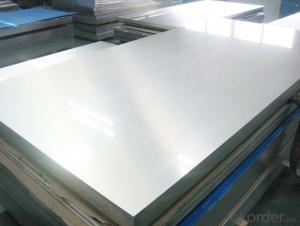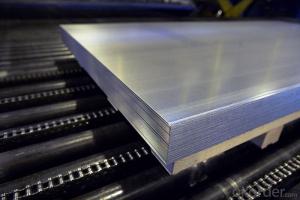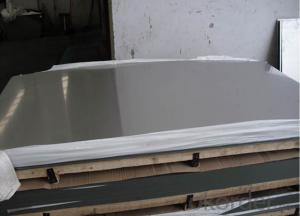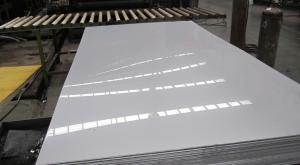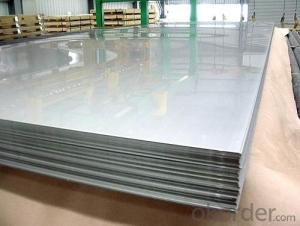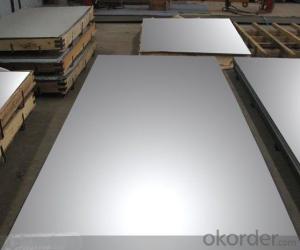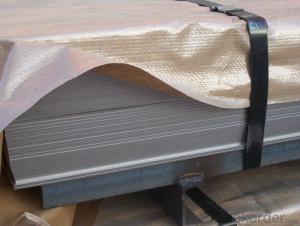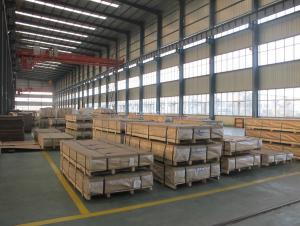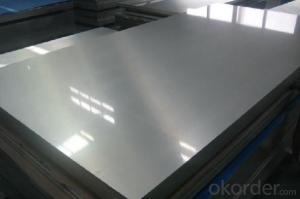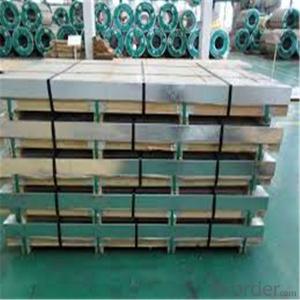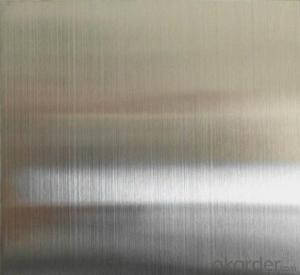Stainless Steel Sheet Plate 430 for Automobile
- Loading Port:
- China main port
- Payment Terms:
- TT OR LC
- Min Order Qty:
- 50 m.t.
- Supply Capability:
- 10000 m.t./month
OKorder Service Pledge
OKorder Financial Service
You Might Also Like
Specification
Stainless Steel Sheet/Plate 430 for Automobile
Description:
304 stainless steel is the most widely used in the 300 series stainless steel. Its anti-corrosion property is stronger than the 200-series
stainless steel, but the anti-acid property is worse than 316. 304 stainless steel have a good resistance in high temperature and the
excellent corrosion resistance. 304 stainless steel is more expensive than 201, cheaper than the 316.
1. Commodity: 304 Stainless Steel
2. Technique: Cold Rolled/hot rolled Stainless Steel
3. Grade: 304 Stainless Steel
4. Type: Stainless Steel Sheet/coil
5. Finish: 2B/Ba/8K/Emboss/Etch
6. Edge: mill edge /silted edge
7.Size:1219mm*2438mm,1219mm*3048mm,or as customized
Main Features:
•Escalator, Elevator, Doors
•Furniture
•Production tools, Kitchen appliances, freezers, cold rooms
•Auto Parts
•Machinery and Packaging
•Equipment and Medical devices
•Transport system
Specifications:
Description | steel sheet,hot rolled steel sheet,cold rolled steel sheet, steel sheet,sheet,steel plate |
Standard | ASME, ASTM, EN ,BS,GB,DIN, JIS etc |
Surface treatment:
Surface finish | Characteristics and application |
2B | The surface brightness and flatness of no2B is better than no2D. then through a special surface treatment to improve its mechanical properties,No2B could nearly satisfy comprehensive uses. |
No.1 | Polished with abrasive belt of grit#100-#200, have better brightness with discontinuous coarse stria, used as inner and external ornaments for building, electrical appliances and kitchen utensils etc. |
No.4 | Polished with abrasive belt of grit #150-#180,have better brightness with discontinuous coarse stria, but thinner than No3, are used as bathtub buildings inner and external ornaments electrical appliances kitchen utensils and food processing equipment etc. |
HL | Polished with abrasive belt of grit #150-#320 on the NO.4 finish and has continuous streaks, mainly used as buildings ornaments elevators, door of building, frontal plate etc. |
BA | Cold rolled, bright annealed and skin-passed, the product have excellent brightness and good reflexivity like mirror, kitchen apparatus, ornament etc. |
8K | The product have excellent brightness and prefer reflexivity can to be the mirror. |
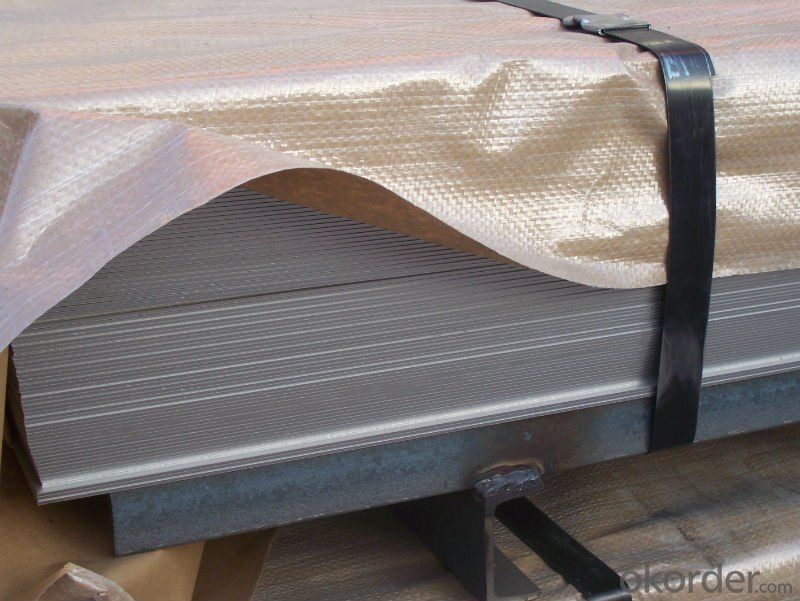
- Q: What are the different types of stainless steel sheet surface treatments available?
- There is a wide range of surface treatments available for stainless steel sheets, each with its own distinct benefits and appearances. Some of the most commonly used treatments are: 1. No.1 Finish: This finish is ideal for industrial purposes and is achieved through hot-rolling, annealing, and pickling. It has a rough texture with visible grain lines. 2. No.2B Finish: Also known as a bright, cold-rolled finish, this treatment provides a smooth and reflective surface with a moderate level of gloss. It is obtained through annealing and pickling. 3. No.3 Finish: By using progressively finer abrasive materials, a finely polished surface is achieved. It has a semi-reflective appearance and is often used for decorative applications. 4. No.4 Finish: Similar to the No.3 finish, but with a higher level of polish, this treatment gives the stainless steel sheet a satin-like appearance. It is commonly used in architectural and kitchen equipment applications. 5. BA (Bright Annealed) Finish: This treatment results in a mirror-like, highly reflective finish. It is achieved by annealing the stainless steel sheet in a controlled atmosphere and is often used for decorative purposes and in the production of household appliances. 6. Embossed Finish: This treatment involves stamping a pattern onto the stainless steel sheet to create a textured surface. It is frequently used for decorative purposes or to enhance grip on surfaces. 7. Colored Finish: Stainless steel sheets can also be treated with various colored coatings, such as gold, black, or bronze. These finishes are achieved through processes like PVD (Physical Vapor Deposition) or electroplating. Each surface treatment offers its own advantages and is suitable for specific applications. When selecting the appropriate treatment for a stainless steel sheet, it is important to consider factors such as durability, corrosion resistance, aesthetic appeal, and intended use.
- Q: Can stainless steel sheets be used for decorative elevator doors or panels?
- Indeed, stainless steel sheets are perfectly suitable for adorning elevator doors or panels in a decorative manner. The versatility of stainless steel as a material is unparalleled, as it not only bestows an exquisite and contemporary appearance but also enjoys great popularity for its decorative applications. Its exceptional durability, resistance to corrosion, and effortless maintenance make it an ideal choice for areas with heavy foot traffic, such as elevator doors and panels. Moreover, stainless steel sheets can be tailored to one's specific preferences by incorporating a wide range of finishes, patterns, and textures, thereby offering limitless design possibilities. Whether one desires a sleek and minimalist aesthetic or a more intricate and decorative motif, stainless steel sheets can elevate the visual appeal of elevator doors and panels while providing enduring functionality.
- Q: Can stainless steel sheets be used in swimming pool applications?
- Yes, stainless steel sheets can be used in swimming pool applications. Stainless steel is a popular choice for swimming pool construction due to its durability, resistance to corrosion, and aesthetic appeal. Stainless steel sheets can be used for various purposes in swimming pools, such as pool walls, floors, stairs, and water features. They offer excellent strength and are highly resistant to corrosion caused by chlorine and other chemicals present in pool water. Additionally, stainless steel is easy to clean and maintain, making it a practical choice for swimming pool applications.
- Q: 430 stainless steel plate maximum temperature tolerance is how many degrees?
- 430 stainless steel plate, maximum heat resistance is 900 degrees celsius.
- Q: Seeking stainless steel plate 304 material and 304j material what is the difference?
- 304J1 is a kind of material in stainless steel plate. Is 304 of copper containing material, deep drawing performance better than 304, mainly for deep processing purposes, but also belong to the nickel series.
- Q: What are the standard sizes and thicknesses of stainless steel sheets?
- Stainless steel sheets come in various standard sizes and thicknesses that are widely used in different industries and applications. The standard sizes typically range from 4 feet by 8 feet to 5 feet by 10 feet, although custom sizes can also be obtained based on specific requirements. Regarding thicknesses, stainless steel sheets are available in several standard options, including 20 gauge (0.036 inches), 18 gauge (0.048 inches), 16 gauge (0.060 inches), 14 gauge (0.075 inches), 12 gauge (0.105 inches), and 10 gauge (0.135 inches). These thicknesses refer to the nominal thickness, and actual thickness may vary slightly. It is important to note that stainless steel sheets can also be obtained in metric sizes, with common thicknesses ranging from 0.5 mm to 3 mm. This allows for flexibility and compatibility with international standards and specifications. Overall, the standard sizes and thicknesses of stainless steel sheets are determined by industry standards and customer requirements, ensuring wide availability and versatility for various applications such as construction, automotive, aerospace, and kitchen equipment manufacturing, among others.
- Q: Are stainless steel sheets suitable for architectural designs?
- Yes, stainless steel sheets are indeed suitable for architectural designs. Stainless steel is a versatile and durable material that offers numerous advantages for architectural applications. It provides a sleek and modern aesthetic while also being resistant to corrosion, rust, and staining. Stainless steel sheets can be easily shaped, bent, and fabricated into various architectural elements such as cladding, panels, handrails, countertops, and more. Additionally, stainless steel is environmentally friendly, as it is fully recyclable and has a long lifespan, making it an excellent choice for sustainable architectural designs.
- Q: Can stainless steel sheets be used for food storage containers?
- Yes, stainless steel sheets can be used for food storage containers. Stainless steel is a popular choice for food storage containers due to its durability, non-reactive nature, and resistance to corrosion. It does not impart any taste or odor to the stored food, making it safe for long-term storage. Stainless steel is also easy to clean and maintain, making it a hygienic option for food storage. Additionally, stainless steel containers are often preferred for their eco-friendly properties, as they are reusable and can help reduce the use of single-use plastic containers. Overall, stainless steel sheets are a suitable and reliable choice for food storage containers.
- Q: What's the difference between stainless steel hot rolling and cold rolling?
- 1. cold-rolled steel plate due to a certain degree of hardening, low toughness, the price is more expensive;2. surface anaerobic cold rolling scale, good quality;3. cold deformation products, high dimensional accuracy, good surface quality;4. cold rolling because of its production process in all walks of life in a wide range of applications, such as various types of cold stamping parts, cold rolled cold extrusion profiles, cold coil spring, cold drawn wire, cold heading bolts.Hot rolling (hot rolling): relative to cold rolling, cold rolling is performed under recrystallization temperature, while hot rolling is rolling above recrystallization temperature.
- Q: What are the different types of embossed finishes available for stainless steel sheets?
- Stainless steel sheets come in a variety of embossed finishes, offering different looks and textures. Some popular options are: 1. Diamond pattern: This embossed finish adds a decorative touch with its raised diamond pattern. 2. Linen pattern: Resembling linen fabric, this textured finish adds depth and visual interest. 3. Leather pattern: Mimicking genuine leather, this embossed finish creates a stylish and unique textured surface. 4. Bead pattern: With its raised, rounded pattern resembling beads, this finish adds a subtle decorative element. 5. Checker pattern: Arranged in a checkerboard pattern, this embossed finish brings a modern and stylish look. 6. Hammered pattern: Resembling hammer marks, this textured finish adds a rustic and handcrafted aesthetic. These examples showcase the variety of embossed finishes available for stainless steel sheets. Each finish offers a distinct look and texture, allowing you to choose the one that best suits your design preferences and application requirements.
Send your message to us
Stainless Steel Sheet Plate 430 for Automobile
- Loading Port:
- China main port
- Payment Terms:
- TT OR LC
- Min Order Qty:
- 50 m.t.
- Supply Capability:
- 10000 m.t./month
OKorder Service Pledge
OKorder Financial Service
Similar products
Hot products
Hot Searches
Related keywords
